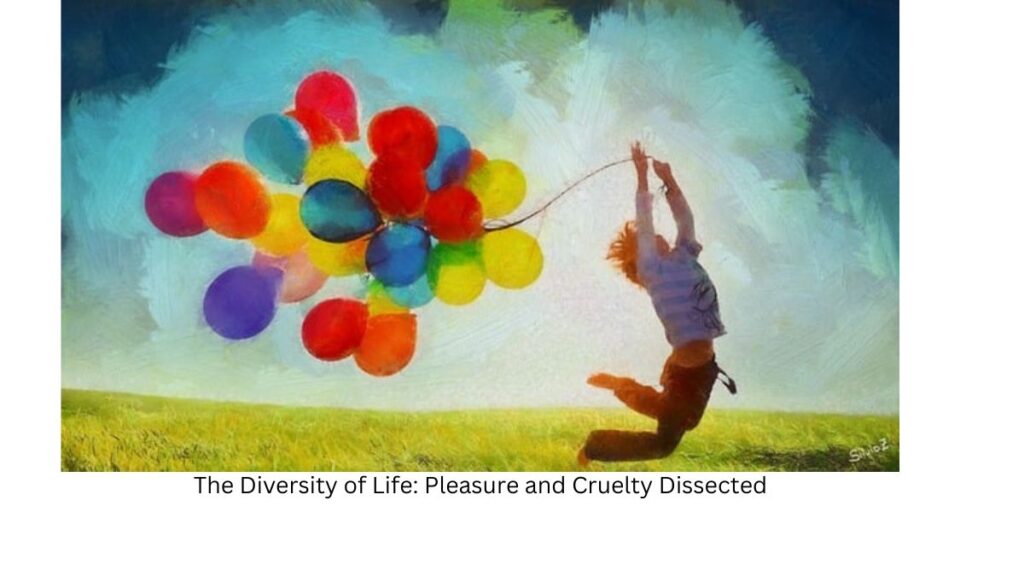Introduction:-
The Diversity of Life: Pleasure and Cruelty Dissected

In the grand tapestry of existence, life unfurls in all its diverse forms, a symphony of pleasure and cruelty intertwined. From the majestic flight of an eagle to the savage hunt of a lion, the living world is a theater where these contrasting elements play out. This article delves into the complexities of life’s diversity, examining the pleasure and cruelty inherent in nature and our role in preserving this intricate balance.
What is the diversity of life summary?
- The Beauty of Biodiversity

Life on Earth is a wondrous spectacle. The rich tapestry of biodiversity encompasses an astounding array of species, each with its unique traits and characteristics. From the resplendent plumage of tropical birds to the delicate grace of underwater corals, the natural world offers a myriad of reasons to celebrate its existence. The pleasure we derive from this diversity is palpable, as it enriches our lives, fosters curiosity, and inspires awe.
- The Circle of Life
Yet, in the same breath, the cruelty of nature’s cycles is equally apparent. The concept of ‘survival of the fittest’ permeates the natural world, where predation and competition are the norm. A lion’s relentless pursuit of its prey or a snake’s venomous strike is a stark reminder of the harsh realities that define the struggle for existence. This cruelty, however, serves a critical purpose in maintaining ecological balance and ensuring the health of ecosystems.
As sentient beings, humans hold a unique position in the web of life. With intelligence and consciousness, we have the ability to shape our relationship with the natural world. Sadly, our actions have often tilted the balance toward cruelty. Deforestation, pollution, overfishing, and habitat destruction threaten the very diversity that sustains us. It is imperative that we recognize our role in perpetuating both pleasure and cruelty in the natural world.
- Conservation Efforts
Acknowledging the consequences of our actions, numerous conservation efforts are underway to preserve and protect the diversity of life on our planet. National parks, wildlife sanctuaries, and marine reserves serve as havens for countless species, providing them with a safe space to thrive. These initiatives are a testament to our commitment to preserving the pleasures of biodiversity and mitigating the cruelty of extinction.
In the quest to understand and appreciate the diversity of life, it is essential to address ethical questions that arise. Is it morally justifiable to interfere in the natural order to protect species from extinction? Are there limits to our intervention, and how do we strike a balance between pleasure and cruelty in the conservation efforts we undertake? These questions require thoughtful consideration as we navigate the complex terrain of biodiversity conservation.
- Finding Harmony
Ultimately, the diversity of life is a complex interplay of pleasure and cruelty. The magnificence of a coral reef and the starkness of a predator’s hunt are both part of this intricate dance. As stewards of the Earth, it is our responsibility to foster an understanding that enables us to appreciate and protect this balance. In doing so, we can work towards a world where pleasure and cruelty in the natural world coexist harmoniously.
Why is diversity of life important?
The diversity of life is of paramount importance for several reasons:

- Ecosystem Stability: Biodiversity plays a crucial role in maintaining the stability and resilience of ecosystems. A diverse range of species can provide essential services such as pollination, pest control, and nutrient cycling. This, in turn, supports the overall health of ecosystems and their ability to withstand environmental changes and disturbances.
- Genetic Diversity: Genetic diversity within species is essential for adaptation and survival. It allows for the development of traits that can help species cope with changing environmental conditions, resist diseases, and adapt to new challenges. A loss of genetic diversity can make species more vulnerable to extinction.
- Human Well-being: Biodiversity is directly linked to human well-being. Many of our essential resources, such as food, medicine, and clean water, are derived from diverse ecosystems. Additionally, diverse ecosystems provide recreational and aesthetic benefits, contributing to the overall quality of life.
- Scientific Understanding: The study of diverse life forms enriches our understanding of biology, ecology, and evolution. It has led to groundbreaking scientific discoveries and innovations in fields like medicine, agriculture, and biotechnology.
- Cultural and Aesthetic Value: The diversity of life is a source of cultural and aesthetic value. It enriches our cultures through art, folklore, and traditions. Many people find solace, inspiration, and enjoyment in the beauty and uniqueness of the natural world.
- Ecological Balance: Each species in an ecosystem has a role to play in maintaining ecological balance. The removal or decline of one species can have far-reaching consequences, disrupting the balance and leading to negative ecological effects.
- Climate Regulation: Forests, wetlands, and other ecosystems help regulate the climate by sequestering carbon dioxide and influencing local weather patterns. Biodiverse ecosystems contribute to the planet’s ability to mitigate climate change.
- Ethical and Moral Considerations: Many people believe in the intrinsic value of all species and ecosystems, advocating for the ethical responsibility to protect and preserve biodiversity for its own sake.
- Long-Term Sustainability: Preserving biodiversity is essential for the long-term sustainability of our planet. It ensures that future generations will have the resources and natural systems they need to thrive.
In summary, the diversity of life is crucial for ecological, economic, cultural, and ethical reasons. It provides us with essential services, enriches our lives, and ensures the sustainability of our planet. Protecting and conserving biodiversity is a fundamental aspect of responsible stewardship of the Earth and the well-being of all living creatures, including humans.
Conclusion
“The Diversity of Life: Pleasure and Cruelty Dissected” invites us to contemplate the intricacies of the natural world. It reminds us that life’s diversity encompasses both the pleasures of awe-inspiring beauty and the cruelties of the survival struggle. As we strive to protect the delicate balance of this diversity, we must recognize our own role in perpetuating both pleasure and cruelty and work towards a future where they coexist in harmony. Our collective efforts to safeguard the wonders of biodiversity can ensure that future generations continue to marvel at the splendors of life on Earth.





